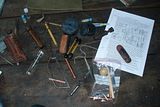Charcloth (duh...)
Horse hoof fungus or 'false tinder fungus' (Fomes fomentarius), the felty trama-layer, scraped into a woolly mass or sliced very thin
Cramp ball fungus (Daldinia concentrica)
Chaga or 'true tinder fungus' (Inonotus obliquus)
'lulut'; the fluffy layer that can be found on the base of the stalks of the fish tail palm (Caryota mitis), (growing in a garden centre near your house...)
The same from the palm Trachycarpus fortunei (it is inferior to C. mitis though)
The fluffy stuff that can be scraped from mullein (Verbascum thapsus) stalks
Artist conk fungus (Ganoderma applanatum); the felty trama layer, untreated
And a new one I found out about yesterday:
The fluff from coltsfoot (Tussilago farfara) seedheads, these consist of slightly thicker fibers than other plant down and don't burn as fast.
This is coltsfoot, I come across it almost everywhere
(clicking on the images will lead you to my photobucket-account with larger sized pictures):

The fluffy seedhead:
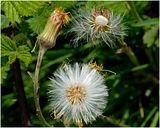
I collected some of the fluff and discarded the seeds, leaving only the white fibers:
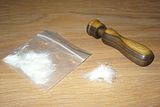
Picked some of the fluff and rolled it into a felt-like ball:
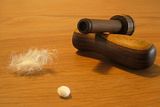
Inserted into the tinder cup of my fire piston:
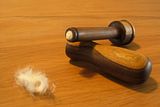
Ready to go:
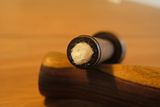
A glowing coltsfoot coal!:
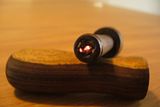
This coltsfoot fluff tinder greatly expands the probabilities of encountering natural tinder for fire pistons as the fungi mentioned above are not common at all in my area (and the palm tinders can only be scraped off illegally from the trees at my local garden centre ).
).
Coltsfoot fluff is a lot harder to light with flint and steel but it can be done.
Cheers,
Tom
Horse hoof fungus or 'false tinder fungus' (Fomes fomentarius), the felty trama-layer, scraped into a woolly mass or sliced very thin
Cramp ball fungus (Daldinia concentrica)
Chaga or 'true tinder fungus' (Inonotus obliquus)
'lulut'; the fluffy layer that can be found on the base of the stalks of the fish tail palm (Caryota mitis), (growing in a garden centre near your house...)
The same from the palm Trachycarpus fortunei (it is inferior to C. mitis though)
The fluffy stuff that can be scraped from mullein (Verbascum thapsus) stalks
Artist conk fungus (Ganoderma applanatum); the felty trama layer, untreated
And a new one I found out about yesterday:
The fluff from coltsfoot (Tussilago farfara) seedheads, these consist of slightly thicker fibers than other plant down and don't burn as fast.
This is coltsfoot, I come across it almost everywhere
(clicking on the images will lead you to my photobucket-account with larger sized pictures):

The fluffy seedhead:

I collected some of the fluff and discarded the seeds, leaving only the white fibers:

Picked some of the fluff and rolled it into a felt-like ball:

Inserted into the tinder cup of my fire piston:

Ready to go:

A glowing coltsfoot coal!:

This coltsfoot fluff tinder greatly expands the probabilities of encountering natural tinder for fire pistons as the fungi mentioned above are not common at all in my area (and the palm tinders can only be scraped off illegally from the trees at my local garden centre
Coltsfoot fluff is a lot harder to light with flint and steel but it can be done.
Cheers,
Tom

